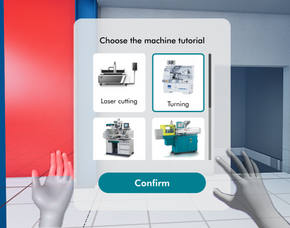
VR Workshop Training
for CUBE University of Twente
November 2024 - February 2025
Group Project · Master Level · Industrial Design Engineering
Course: Virtual Reality
This course explored the application of Virtual, Augmented, and Mixed Reality (VR/AR/MR) tools within product development processes. Rather than developing new technologies, the focus was on integrating existing digital tools to create immersive, multisensory solutions that support real-world stakeholders.
This project explores the integration of VR tools in the new CUBE workshop facility of the University of Twentr. The aim was to design an immersive pre-training solution to help students become familiar with workshop machines, safety protocols, and operational procedures before engaging in hands-on work. Through research, stakeholder input, and iterative prototyping, a comprehensive system was created that includes VR tutorials, a training progress dashboard, and integration with workshop access. The proposed solution is expected to enhance safety, reduce staff workload, and increase student confidence.
Problem Definition
With the launch of the CUBE building as a centralised prototyping workshop at the University of Twente, a clear need emerged for improving student preparation and safety. Many students were unfamiliar with machinery, struggled with selecting appropriate materials, and frequently required repetitive in-person instruction. Workshop staff faced high workloads, and machine misuse posed safety risks. The challenge was to develop a digital training solution—leveraging VR or AR—to support students in preparing independently, while ensuring effectiveness, inclusivity, and safety compliance.
Methodology
The process began with a comprehensive exploration of state-of-the-art VR/AR technologies and their application in education and technical training. Stakeholder insights were collected via student surveys and interviews with workshop staff. Two concepts—an AR live guidance system and a VR pre-training module—were proposed. Based on feedback and feasibility, the team focused on the VR concept. Using Unity, a prototype was developed and iteratively refined through feedback from midterm and demo-day presentations. Key improvements included non-linear learning paths, multilingual support, and options for different training modes.
Final Results
The final solution consists of a modular training ecosystem combining a web platform, VR tutorials, and workshop system integration. Students upload their design files and receive machine and material feedback. They can then access immersive VR training via home, campus VR labs, or a simplified non-VR interface. The system includes two modes: a guided tutorial and a self-directed practice module with real-time feedback. Completion is logged and linked to student IDs for machine access control. The design reduces safety risks, improves readiness, and lightens the burden on workshop staff. A phased implementation plan ensures feasibility and scalability.
Personal Contributions
My main responsibility in this project was conducting the stakeholder analysis to ensure the final concept aligned closely with real user needs. I conducted an in-depth interview with a workshop staff member to understand operational pain points and safety concerns, and I also designed and distributed a student survey to gather insights on their current challenges and preferences regarding machine use. I analysed the collected data and translated key findings into actionable design criteria, which informed the direction of our concept development. In addition to the research phase, I contributed to shaping and refining the final concept to ensure it remained grounded in user realities throughout the process.










